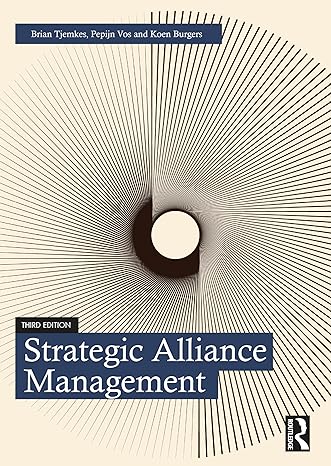In October 1933, N.V. De Bataafsche Petroleum Maatschappij (now Royal Dutch Shell) offered the Standard Oil Company
Question:
In October 1933, N.V. De Bataafsche Petroleum Maatschappij (now Royal Dutch Shell)
offered the Standard Oil Company of New Jersey (now ExxonMobil) the opportunity to pool oil exploitation interests in the Netherlands on a 50:50 basis. The offer was accepted in 1938.
However, because of the Second World War, it took until 1947 to formalize the arrangement by forging the Nederlandse Aardolie Maatschappij (NAM). In 1948, NAM discovered 152 Supplier alliances natural gas in the Dutch town of Coevorden. Just more than ten years later, NAM discovered the Groningen natural gas feld near Slochteren, one of the largest on-shore natural gas felds in the world. That discovery led to the establishment of the so-called Gasgebouw in 1963, the objective of which was to exploit the Groningen gas reserves. Gasgebouw was a partnership between NAM, the Dutch State Mines NV (now Energie Beheer Nederland BV) and the newly formed gas marketing and transportation company Gasunie. Twenty-nine gas locations and six metering stations were developed in the 1960s and 1970s to exploit the Groningen gas feld.
After 30 years of operation, renovation of the facilities was necessary to ensure compliance with the latest environmental standards and operational requirements. A major and complex renovation project had to be undertaken while still meeting the Groningen feld’s contractual production obligations. The competences required to execute the renovation project were not available within the NAM organization, and contractors (that is, suppliers) were considered to play an important role. However, instead of engaging in competitive bidding procedures2 with multiple parties, NAM decided to opt for an integrated entity that would accept responsibility for execution of the entire project. In so doing, NAM would reduce governance complexity. Furthermore, due to the strategic value of the Groningen gas feld and the scope of the programme, NAM also wanted to avoid a ‘hit-and-run’ mentality as it was important to meet the objectives that had been set for continuous gas production and costs reductions while executing the renovation. One implication was that ongoing maintenance had to be done by the same party responsible for the renovation, although these activities would be organized in two separate agreements. Another implication was that both the NAM and its subcontractor would have to make considerable alliance-specifc investments. The upshot was that a long-term supplier alliance was deemed the most viable option.
Partners were pre-selected based on their experience, size and innovative capacity. NAM insisted that consortia would be formed if partners were unable to deliver the project alone. All parties in a consortium had to share liabilities, which stimulated partnership and commitment within the consortium. Three consortia were asked to produce a conceptual design based on a NAM reference case and functional specifcations. NAM was pleasantly surprised with the level of innovation in the designs. Based on a functional tender, the consortium Stork GLT was awarded the contract due to having the best performance on quality, integrated approach and costs.
Questions 1 Explain NAM’s motives to forge a supplier alliance instead of using their unique position to play of multiple suppliers against each other.
2 Explain the efectiveness of the supplier alliance’s design and management. Also, explain what would change if the alliance would encompass learning and innovation objectives.
Step by Step Answer:

Strategic Alliance Management
ISBN: 978-1032119250
3rd Edition
Authors: Brian Tjemkes ,Pepijn Vos ,Koen Burgers






